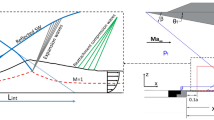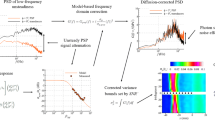Abstract
Flow over thin elastic panels that undergo small amplitude vibrations has a common occurrence in supersonic and hypersonic platforms. The resulting fluid–structure interactions (FSI) are shown to excite the panel oscillation over different elastic modes. The consequent pressure field over the panel poses a stiff measurement challenge because of the fundamental limitations with using pressure transducers. Fast response pressure-sensitive paints make a viable alternative to unravel the pressure dynamics over the panel surface. However, the dominant contribution from the camera noise and the finite number of images acquired introduce broadband fluctuations in the pressure fluctuation power spectral density (PSD) over the panel surface that mask the elastic mode contributions to the PSD in weakly coupled FSI. In this work, an approach is introduced to unearth the elastic mode contributions in the PSD of the panel surface pressure. This approach involves averaging multiple power spectra over a representative region to subdue the broadband fluctuations while retaining the elastic mode contributions. The number of samples to be averaged is determined from the theoretical scaling of the r.m.s. of the broadband spectral fluctuations with averaging. This approach is demonstrated in an impinging shock boundary layer interaction (SBLI) unit generated over an elastic panel at a Mach number of 2.5. The PSD within the incoming boundary layer revealed an elastic mode contribution in the (2,1) mode with spectral sample averaging that was otherwise submerged within the broadband noise. Similarly, the contributions from the different elastic modes were revealed within the intermittent region and the relaxing boundary layer with spectral sample averaging. Whereas the Welch’s algorithm to compute the PSD retained the noise floor, the use of cross-spectral density significantly mitigated the noise floor and provided a more accurate determination of the PSD.
Graphic abstract

















Similar content being viewed by others
References
Blevins R, Holehouse I, Wentz K (1993) Thermoacoustic loads and fatigue of hypersonic vehicle skin panels. J Aircr 30(6):971–978
Brouwer K, Perez R, Beberniss T, Spottswood S, Ehrhardt D (2021a) Experiments on a thin panel excited by turbulent flow and shock/boundary-layer interactions. AIAA J 59(7):2737–2752
Casper K, Beresh S, Henfling J, Spillers R, Hunter P, Spitzer S (2019) Hypersonic fluid-structure interactions due to intermittent turbulent spots on a slender cone. AIAA J 57(2):749–759
Culler A, McNamara J (2010) Studies on fluid–thermal–structural coupling for aerothermoelasticity in hypersonic flow. AIAA J 48(8):1721–1738
Currao G, Neely A, Kennell C, Gai S, Buttsworth D (2019) Hypersonic fluid–structure interaction on a cantilevered plate with shock impingement. AIAA J 57(11):4819–4834
Daub D, Willems S, Gülhan A (2016) Experiments on the interaction of a fast-moving shock with an elastic panel. AIAA J 54(2):670–678
Dowell E (1966) Nonlinear oscillations of a fluttering plate. AIAA J 4(7):1267–1275
Dowell EH (1989) A modern course in aeroelasticity, vol 3. Kluwer academic publishers, Dordrecht, The Netherlands
Egami Y, Sato Y, Konishi S (2019) Development of sprayable pressure-sensitive paint with a response time of less than 10 μ s. AIAA J 57(5):2198–2203
Frank J, Kaiser S (2008) High-resolution imaging of dissipative structures in a turbulent jet flame with laser Rayleigh scattering. Exp Fluids 44(2):221–233
Freydin M, Levin D, Dowell E, Varigonda S, Narayanaswamy V (2020) Natural frequencies of a heated plate: Theory and experiment. AIAA J 58(11):4969–4973
Funderburk M, Narayanaswamy V (2019a) Spectral signal quality of fast pressure sensitive paint measurements in turbulent shock-wave/boundary layer interactions. Exp Fluids 60(10):1–20
Ganapathisubramani B, Clemens N, Dolling D (2006) Large-scale motions in a supersonic turbulent boundary layer., 556, p. 271. J Fluid Mech 556:271–282
Goller T, Musta M, Uehara D, Sirohi J, Clemens N (2018) Experimental study of a compliant panel under a Mach 2 compression ramp interaction.
Gomez-Vega N, Gramola M, Bruce P (2020) Oblique shock control with steady flexible panels. AIAA J 58(5):2109–2121
Gregory J (2004) Porous pressure-sensitive paint for measurement of unsteady pressures in turbomachinery. AIAA. 0294.
Gregory J, Sakaue H, Liu T, Sullivan J (2014) Fast pressure-sensitive paint for flow and acoustic diagnostics. Annu Rev Fluid Mech 46:303–330
Jiao L, Liu X, Shi Z, Zhang W, Liang L, Chen X, Zhao Q, Peng D, Liu Y (2020) A two-dimensional temperature correction method for pressure-sensitive paint measurement on helicopter rotor blades. Exp Fluids 61(4):1–11
M. Funderburk and V. Narayanaswamy (2019b) Investigation of negative surface curvature effects in axisymmetric shock/boundary-layer interaction. AIAA J 57(4):1594–1607
McMullen R, Huynh DP, Gregory J (2013) Dynamic Calibrations for Fast-Response Porous Polymer/Ceramic Pressure-Sensitive Paint. AIAA. 3123
McNamara J, Friedmann P (2011) Aeroelastic and aerothermoelastic analysis in hypersonic flow: past, present, and future. AIAA J 49(6):1089–1122
Mendoza D (1997) An analysis of CCD camera noise and its effect on pressure sensitive paint instrumentation system signal-to-noise ratio.
Mitsuo K, Asai K, Hayasaka M, Kameda M (2003) Temperature correction of PSP measurement using dual-luminophor coating. J Visualization 6(3):213–223
Musta M, Vanstone L, Eitner M, Sirohi J, Clemens N (2019) A compression-ramp shock/boundary-layer interaction over a compliant panel at Mach 5.
Neet M, Austin J (2020) Effects of surface compliance on shock boundary layer interaction in the caltech Mach 4 ludwieg tube. AIAA. 0816
Noda T, Nakakita K, Wakahara M, Kameda M (2018) Detection of small-amplitude periodic surface pressure fluctuation by pressure-sensitive paint measurements using frequency-domain methods. Exp Fluids 59(6):1–12
Ozawa Y, Nonomura T, Mercier B, Castelain T, Bailly C, Asai K (2019) Cross-spectral analysis of PSP images for estimation of surface pressure spectra corrupted by the shot noise. Exp Fluids 60(8):1–11
Pandey A, Casper K, Soehnel M, Spillers R, Bhakta R, Beresh S (2021) Hypersonic fluid-structure interaction on the control surface of a slender cone. AIAA. 0909
Peltier S, Rice B, Szmodis J, Ogg D, Hofferth J, Sellers M, Harris A (2019) Aerodynamic response to a compliant panel in mach 4 flow. AIAA. 3541
Peng D, Jensen C, Juliano T, Gregory J, Crafton J, Palluconi S, Liu T (2013) Temperature-compensated fast pressure-sensitive paint. AIAA J 51(10):2420–2431
Pickles J, Narayanaswamy V (2020) Control of fin shock induced flow separation using vortex generators. AIAA J 58(11):4794–4806
Pickles J, Mettu B, Subbareddy P, Narayanaswamy V (2019) On the mean structure of sharp-fin-induced shock wave/turbulent boundary layer interactions over a cylindrical surface. J Fluid Mech 865:212–246
Running C, Juliano T (2021a) Global measurements of hypersonic shock-wave/boundary-layer interactions with pressure-sensitive paint. Exp Fluids 62(5):1–18
Running C, Juliano T (2021b) Global skewness and coherence for hypersonic shock-wave/boundary-layer interactions with pressure-sensitive paint. Aerospace 8(5):123
Schoneich A, Whalen T, Laurence S, Sullivan B, Bodony D, Freydin M, Dowell E, Stacey L, Buck G (2021) Fluid-thermal-structural interactions in ramp-induced shock-wave/boundary-layer interactions at Mach 6. AIAA. 0912.
Spottswood SM (2018) Exploring the response of a thin, flexible panel to supersonic turbulent flow and shock boundary-layer interactions (sbli). J Sound Vib 443:74–89
Spottswood S, Beberniss T, Eason T, Perez R, Donbar J, Ehrhardt D, Riley Z (2019) Exploring the response of a thin, flexible panel to shock-turbulent boundary-layer interactions. J Sound Vib 443:74–89
Tripathi AGJ, Shoele K, Kumar R (2021) Response of a compliant panel to shock boundary layer interaction at Mach 2. AIAA. 0489.
Varigonda S, Narayanaswamy V (2019) Investigation of shock wave oscillations over a flexible panel in supersonic flows. AIAA. 3543.
Varigonda S, Narayanaswamy V, Boxx I, Simultaneous measurement of pressure and velocity fields of an oblique SBLI on a flexible panel using PIV and PSP. AIAA. 3001
Varigonda S, Jenquin C, Narayanaswamy V (2021) Impact of Panel Vibrations on the Dynamic Field Properties in Supersonic flow. AIAA AVIATION 2021 FORUM, p. 2926
Wang G, Clemens N (2004) Effects of imaging system blur on measurements of flow scalars and scalar gradients. Exp Fluids 37(2):194–205
Whalen T, Schöneich A, Laurence S, Sullivan B, Bodony D, Freydin M, Dowell E, Buck G (2020) Hypersonic fluid–structure interactions in compression corner shock-wave/boundary-layer interaction. AIAA J 58(9):4090–4105
Acknowledgements
This work was sponsored by a grant sponsored by Air Force Office of Scientific Research with Dr. Sarah Popkin as the Program Manager (Grant No. FA9550-19-1-0313).
Author information
Authors and Affiliations
Corresponding author
Additional information
Publisher's Note
Springer Nature remains neutral with regard to jurisdictional claims in published maps and institutional affiliations.
Rights and permissions
About this article
Cite this article
Varigonda, S.V., Narayanaswamy, V. Methodology to image the panel surface pressure power spectra in weakly coupled fluid/structure interactions. Exp Fluids 62, 237 (2021). https://doi.org/10.1007/s00348-021-03314-4
Received:
Revised:
Accepted:
Published:
DOI: https://doi.org/10.1007/s00348-021-03314-4




